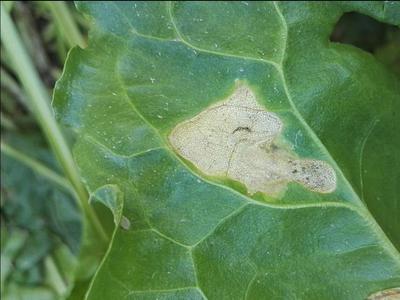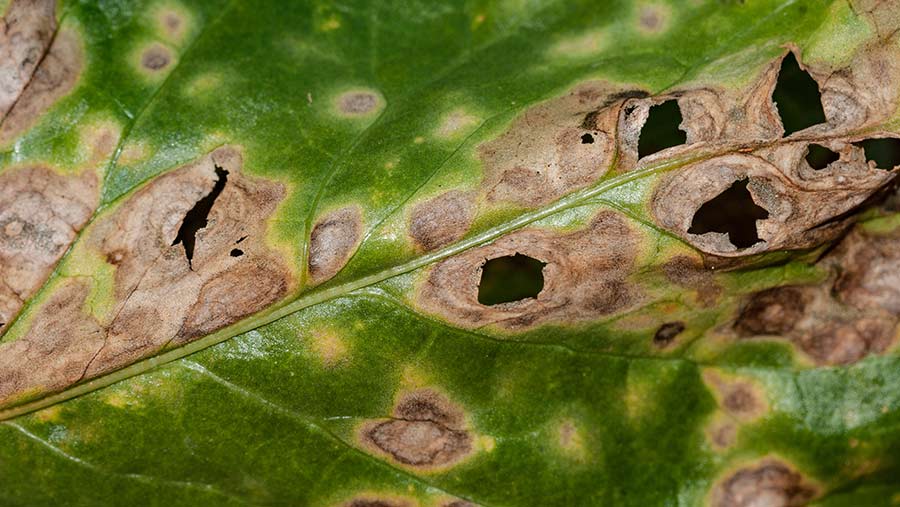
Ramularia
Ramularia Betícola
Pathogen:
Fungus
Type:
Risk:
HIGH
Micosis/Hongos
Remolacha de mesa


WHO CAUSES IT?
Ramularia betícola is a phytopathogenic fungus that mainly affects beets. This fungus produces conidial spores that are spread through wind, water, and contaminated tools. Spore germination occurs under conditions of high humidity and moderate temperatures. Once the spores germinate, the fungus penetrates the plant tissues, mainly through stomata and wounds. Inside the plant, the fungus develops intercellular mycelium and produces new spores in infected tissues, thus perpetuating its spread and the infection cycle. The fungus can survive in the remains of infected plants and in the soil, which facilitates its persistence and reappearance in subsequent crops.
SYMPTOMS
Ramularia caused by Ramularia betícola significantly affects beets, manifesting first in the lower leaves and progressing to the upper ones. Early signs include small chlorotic Taches that develop into dark brown necrotic lesions, surrounded by a yellow halo. These lesions can coalesce, causing significant defoliation and reducing photosynthesis and crop yield. Under severe conditions, plants may experience widespread wilting and premature death.
- Small chlorotic Taches on the leaves.
- Dark brown necrotic lesions with a yellow halo.
- Coalescence of lesions causing defoliation.
- Reduction of photosynthesis.
- Generalized wilting.
- Premature death of the plant.


TEMPERATURE AND HUMIDITY
15°C - 25°C
80% - 95%
TRANSMISSION PATHS
Wind, Irrigation water, Contaminated tools, Infected crop remains
Do you want to remove this pest? Choose how you want to treat it.
TREATMENTS
Chemical treatment
-
Authorized treatments in organic farming
-
Biological control
-
Recommendations
- Crop rotation, avoiding planting beets and other susceptible plants in the same area for several years.
- Use of resistant beet varieties.
- Application of specific preventive and curative fungicides.
- Removal and destruction of infected crop remains.
- Improved soil drainage to reduce excessive moisture.
- Disinfection of tools and agricultural machinery.
- Regular monitoring of the crop for early detection of symptoms.
- Implementation of integrated pest management practices (IPM).
Sponsored link
Sponsored link
Sponsored link
Sponsored link
Sponsored link
Sponsored link
Effective against all types of fungi
TREATMENTS
Homemade treatments
There are no home treatments
Natural allies
Chemical treatments
There are no treatments for this disease. Treatments are directed at the insect vectors that transmit it. See insect treatments.
RECOMMENDATIONS
- Check the back of the leaves frequently, especially in dry weather.
- Spray water on the leaves to increase humidity and prevent them from settling.
- Keep plants healthy with good watering and adequate light.
- If you see cobwebs or damage, clean the leaves with a damp cloth or pressurized water.
- Use potassium soap or neem oil every few days until they disappear.
REPELLENT PLANTS
Rosemary, Dill, Coriander
RECOMMENDED PRODUCTS TO ELIMINATE THIS PEST
Sponsored link
Sponsored link
Sponsored link
Sponsored link
Sponsored link
Sponsored link
Effective against all types of fungi
*The recommended treatments are still recommendations according to the databases of the authorities and at no time do they replace the guidelines established according to the legislation of each country
*The products shown are recommendations and are not our own products. As Amazon Associates, we earn revenue from purchases of recommended products.






















